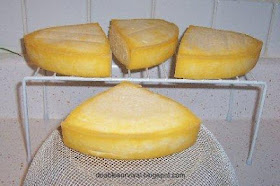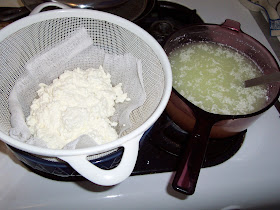Making Cheddar Cheese
(Cheddar is naturally white. To color it yellow, add Annatto.)
I love cheese. Of course, you don't have to have cheese to survive; but if you have access to milk,
it would be nice to still be able to have it around, even in tough times. It's cheaper to make too, and you
could even use it to barter. If you have cows or goats or know someone who does, you may want to try it now and practice a little. :) You can use store-bought milk also. I had to use that as raw milk is actually illegal to sell retail in some states, including mine. Also, you can wax hard or low-moisture cheeses and let them age and store for years. I plan to also buy cheddar when it is on sale and wax it to store. I am new at cheese making myself.
Cheddar worked out much better for me than Mozzarella did even though it takes more effort. When I first started reading about making cheddar, I read about how you have to have a cheese press, cheese molds, etc., which I can't afford. It sounded too complicated; but after looking at how-to sites on how to make your own molds and presses, I got the general idea of it. It isn't as hard as it sounds. I used two ice cream buckets/pails to make a cheese mold. I made one out of two large lard containers too, but I like the ice cream buckets better. (I buy lard to make a suet recipe for the birds.) There are some home-made cheese press directions that look pretty easy, and I still plan to make one; but for now, I simply used a board over the top of the press with the weights on top. (More on that below.) If you have small children or pets that might tip over the weights, you definitely want to secure it better somehow.
You need a thermometer that registers lower numbers like a dairy or meat thermometer. Most candy thermometers don't go that low. Also, use a non-reactive pot: stainless steel, glass, enamel. Here's an article on that if you want to read more. (click here)
Here is a web site with more tips about making your own cheese molds. (click here)
Here is a web site with directions on making a cheese press, even just to give you a general idea of how to make one with dowels or rods coming up from the base to hold it steady (click here)
Cheddar worked out much better for me than Mozzarella did even though it takes more effort. When I first started reading about making cheddar, I read about how you have to have a cheese press, cheese molds, etc., which I can't afford. It sounded too complicated; but after looking at how-to sites on how to make your own molds and presses, I got the general idea of it. It isn't as hard as it sounds. I used two ice cream buckets/pails to make a cheese mold. I made one out of two large lard containers too, but I like the ice cream buckets better. (I buy lard to make a suet recipe for the birds.) There are some home-made cheese press directions that look pretty easy, and I still plan to make one; but for now, I simply used a board over the top of the press with the weights on top. (More on that below.) If you have small children or pets that might tip over the weights, you definitely want to secure it better somehow.
You need a thermometer that registers lower numbers like a dairy or meat thermometer. Most candy thermometers don't go that low. Also, use a non-reactive pot: stainless steel, glass, enamel. Here's an article on that if you want to read more. (click here)
Here is a web site with more tips about making your own cheese molds. (click here)
Here is a web site with directions on making a cheese press, even just to give you a general idea of how to make one with dowels or rods coming up from the base to hold it steady (click here)
Farmhouse Cheddar Cheese
2 gallons whole milk. You can use raw milk, cow or goat, or store-bought.
1 packet direct-set mesophilic starter or 1/2 C (4 ounces) of prepared mesophilic starter
1/2 teaspoon liquid rennet (or 1/2 rennet tablet) diluted in 1/4 cup (unchlorinated) water
1 tablespoon cheese salt
Annatto (optional, for the yellow color. This is what makes butter and cheddar yellow.)
(The container with the blue lid is
the starter I had prepared earlier.)
(Heating to 90 degrees.)
Heat the milk to 90 degrees in a large pot, (goat’s milk 85 degrees). I found a medium stockpot worked well. Add the starter and stir. Cover and let it sit for 45 minutes. Then, add the diluted rennet and stir in gently for about 1 minute. (If using fresh cow milk, stir no more than 1/2-inch deep.) Cover and let it sit, keeping the pot at 90 degrees (85 for goat’s milk) for 45 minutes or until you can get a clean break with the curds. Use a knife to cut the curds in about 1/2-inch cubes. (The curds should stay intact if lifted.) Very slowly raise the temperature up to 100 degrees, about 2 degrees every 5 minutes. Stir occasionally, carefully. Then, cover and let sit for 5 minutes. Line a strainer with cheesecloth and put the curds in the strainer.
You can tie up the ends of the cheesecloth and hang it from a stick or something to let the curds drain. I let mine sit in the strainer and lifted it up now and then to gently push a little more whey out. After an hour or so, put the curds in a bowl and break it up with your fingers, mixing in the salt.
Line the cheese press with cheesecloth and put the curds in. Press the curds down with your hand and fold the cheesecloth over the top. Put the follower in (the part that presses the cheese)and add weight, 10 pounds for 10 minutes, flip the cheese; 20 pounds for 10 minutes, flip the cheese; 50 pounds for 12 hours.
Air dry the cheese until it forms a rind, 2-4 days and then you can wax it and age it. I put it on something that lets the air get under it too. Flip it over occasionally to dry it evenly.
(Break up the curds and mix in the salt.)
(I used ice cream buckets to make a cheese mold. I found I had
to cut the top edge off both of them for them to press the
cheese properly. I used a drill to put the holes in the bottom one.)
(Fold the cheese cloth over.)
(My fancy schmancy cheese press! lol I used bricks, 5 pounds each, at first.
I put the mold on top of a sturdy bowl so that the holes in the bottom of the mold
wouldn't be blocked. The whey can run out in the bowl or out in the dish.)
(Then, I added a cement block, 45 pounds, and a brick on top. I put it
between my baker's rack and a table to keep it safe. I also put something in
front of it overnight so it couldn't tip over if one of my cats jumped up on it.)
(See the whey pressing out?)
(After it's pressed, unwrap the cheese cloth.)
(Ta da! Cheddar cheese! It has to age though!)
(I cut it into 4 smaller wedges.)
(It has to air dry now for 2-4 days.)
After a few days of drying, it forms a rind.
(I may have added a touch more Annatto than necessary.)
When I take the wax off, I find the dried out part, rind, has
softened again; so that doesn't get wasted.
When I take the wax off, I find the dried out part, rind, has
softened again; so that doesn't get wasted.
Waxing Cheese
Heat cheese wax until melted in a double boiler
(water in a bottom pan).
Dip one end and let it dry. It dries fast. Then, dip it in the
other way. Then repeat. It's better to do a couple of
coats than to try to do one thick one.
A lovely waxed wedge of cheddar cheese! :)
Ready to age.
I read, ideally, it should be kept at 46-52 degrees. You can age it in the refrigerator though. Keep it out of daylight. You can age it as long as you want, anywhere from 6 weeks to 18 months or so for sharp cheddar. I still have to do more reading on that and will do an update.
__________
This is the cheese press I made out of lard containers.
I like the ice cream buckets better as it isn't as thick.
This was the batch I made with the lard containers.
You can read some FAQ on cheese making here. (click here)
Update: mmmm I broke into a batch I made in mid-February (this being 4/29) and it's very tasty. Too early to be sharp, just a mild flavor. The wax had split open on this one. I need to make sure to press it long enough and then dry it long enough.
Thanks for checking out my blog.
You can leave a comment below. You don't have to sign up. :)








































